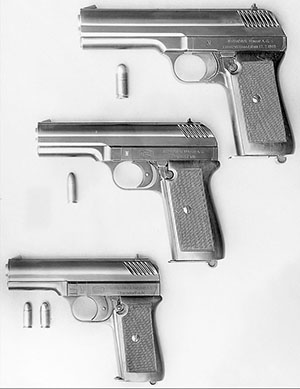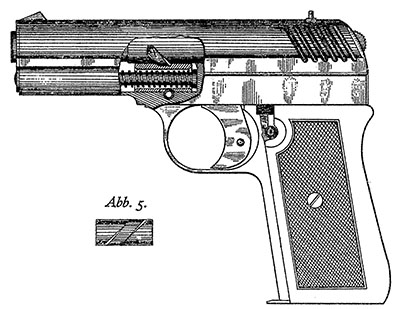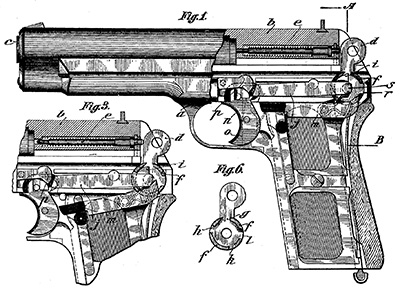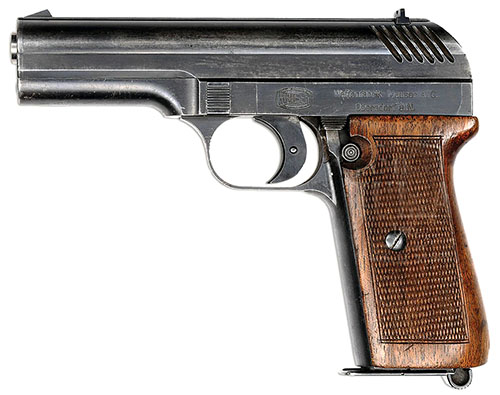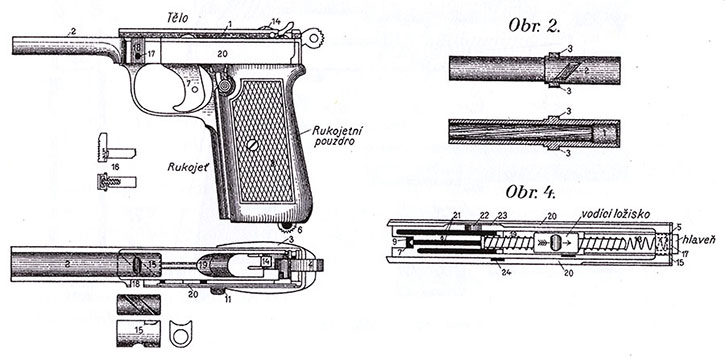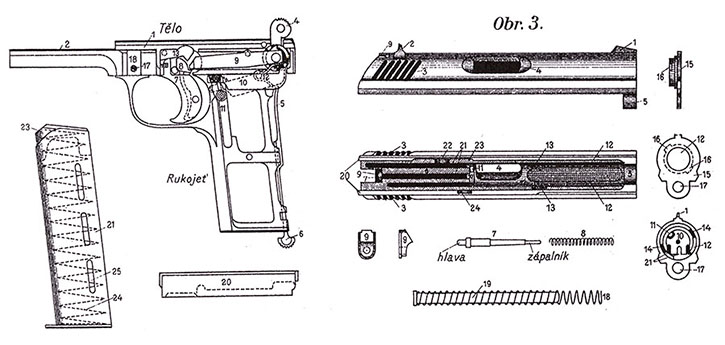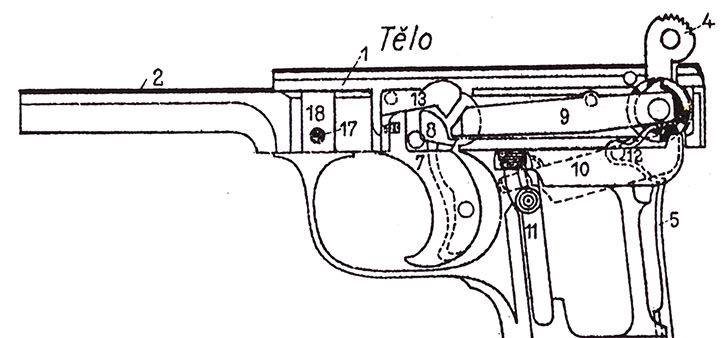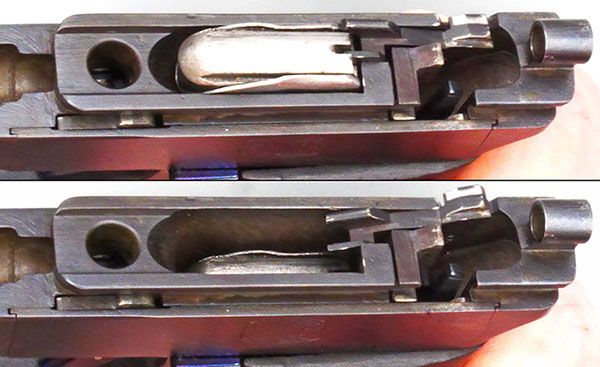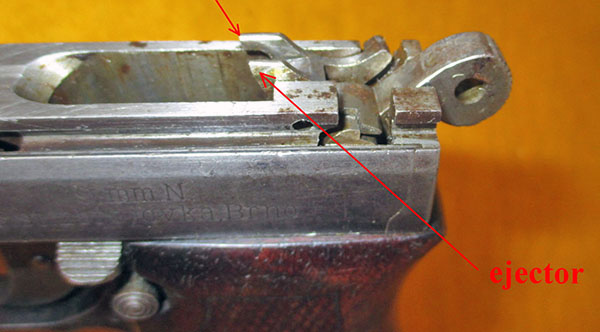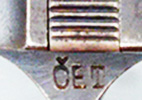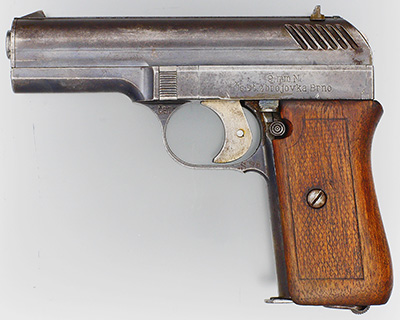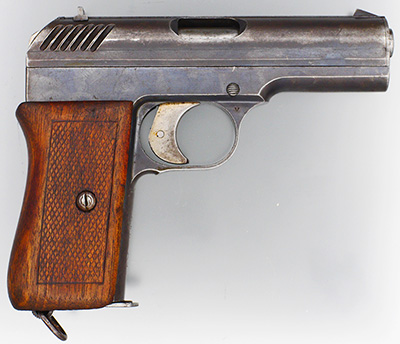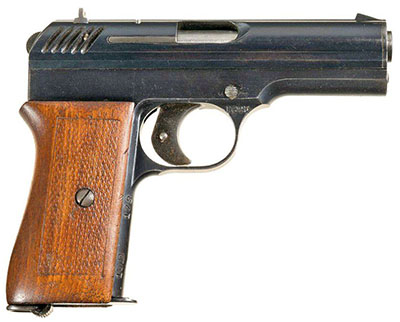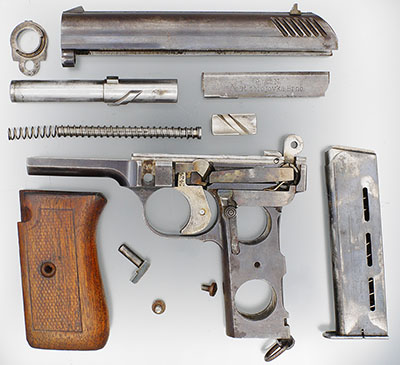 |
||||||||||||||||||||||||||||||||||||||||||||||||||||||||||||||||||||||||||||||||||||||||||||||||||||||||||||||||||||||||||||||||||||||||||||||||||||||||||||||||||||||||||||||||||||||||||||||||||||||||||||||||||||||||||||||||||||||||||||||||||||||||||||||||||||||||||||||||||||||||||||||||||||||||||||||||||||||
|
The Zbrojovka Brno vzor 22 Pistol by Ed Buffaloe This pistol is sometimes mistakenly referred to as the CZ-22, but it was made by Zbrojovka Brno rather than Česka Zbrojovka, so it is not a CZ pistol. “Vzor” is the Czech word for “model”. The gun is more properly called the Zbrojovka Brno Model 1922. Historical Background
From about 1910, Mauser was interested in producing a military pistol to compete with the P-08 Luger, hoping to create a design that would be simpler and cheaper to manufacture than the Luger, and smaller and more ergonomic than the C-96 Mauser. This story is told in detail in the book Mauser Pistolen, pages 97-135. Josef Nickl was intimately involved in the effort and, by 1912, at the age of 40, he had become Mauser’s chief engineer, devoted entirely to pistol development. In summer 1915, Nickl essentially appropriated the design of the 1912 Steyr-Hahn, and created a prototype pistol with a rotating barrel, utilizing a helical lug to rotate the barrel and six locking lugs that mate with cuts in the frame. A cam or bearing with a helical groove to accept the barrel’s helical lug fits at the rear of the recoil spring guide rod, and is held in place by a locking pin inserted through the bottom of the frame in front of the trigger guard. A number of these early prototypes are chambered for the .45 ACP cartridge, as well as the 9mm Parabellum. In later variants, the trigger guard serves as the locking piece for the cam, and rotates 90 degrees to allow separation of the slide from the frame. The letter “N”, often found at the front of the sideplate, indicates a Nickl prototype.
The rotating barrel design was improved and simplified in succeeding years. Locking lugs were reduced to four, and then two. Models made in 1915 featured either an internal hammer or an external hammer. The external hammer design was referred to as the “Modell H.” A 1917 Modell H is the first Nickl prototype known to have been chambered in the 9mm Nickl cartridge, which was developed sometime between 1916 and 1917. The 9mm Nickl cartridge is essentially the 9mm Browning Short (.380 ACP) with a rimless case (whereas the Browning cartridge is “semi-rimmed”) but the difference in rim diameter is almost negligible (about 4 thousandths of an inch). For all practical purposes, the two cartridges were interchangeable. Skramoušský gives a muzzle velocity of 300 meters per second (984 feet per second) for the Czech version of the Nickl cartridge, which is about equivalent to the 950 feet per second usually given for the .380 ACP; though there are sources that say the German cartridge was loaded considerably hotter.
The exigencies of weapons production during WWI prevented Mauser from tooling up for the manufacture of a new pistol during the war, and restrictions imposed by the victors after the war likewise prevented the gun from ever going into production. After WWI, the newly formed country of Czechoslovakia was faced with starting an arms industry to provide weapons for the military. Skramoušský states that the Brno Armory (Zbrojovka Brno) was established by a decree of the Ministry of National Defense on 20 January 1919. From 1918-1919, this facility was known as Státní zbrojovka a strojírna v Brně (State Armory and Machine Shop in Brno); from 1919-1923 it was known as Československá státní zbrojovka (Czechoslovakian State Armory); from 1924-1935 it was known as Československé závody na výrobu zbraní akc. spol. v Brně (Czechoslovakian arms manufacturing plants, joint-stock company, Brno); and from 1935-1939 it became Československá Zbrojovka, a. s., Brno. During the war years (1939-1945) it was referred to as Zbrojovka Brno, a. s., Waffenwerke Brünn, Aktiengesellschaft. The government quickly purchased a large supply of parts for Model 1895 Austrian Mannlicher rifles, including gauges, tools and other necessities. These Mannlicher rifles were assembled at the Brno factory.
The Ministry of Defence also negotiated with the Mauser company for the purchase of a license and machinery to manufacture the Mauser Model 1898 rifle. Skramoušský continues: “In the course of complex negotiations, which included the consent of the victorious powers to export machinery from Germany, the offer of the Mauser company was expanded in March 1920 by a contingent numbering 220 machines, equipped for the production of Nickel pistols in 9 mm Parabellum caliber. This pistol, produced in small quantities by the Mauser factories, was designed by engineer Josef Nickel, the chief foreman... The first shipment of machines from Oberndorf was sent at the beginning of May 1920. Further shipments were delivered to Brno throughout 1921.” The deliveries required more than 500 fully loaded railway cars. Skramoušský does not mention Josef Nickl in Czechoslovakia, but Gordon Bruce says: “Josef Nickl was dispatched to supervise the installation... Because of his ability to converse on a technical level with the engineers at Strakonice...he was able to assist with the initial production of his pistol at the new location.” Presumably, having grown up near the border with Bohemia, Nickl was able to speak Czech, and so was the ideal intermediary between Mauser and the Czech engineers. Production in Czechoslovakia The final Nickl rotary barrel design features essentially the same skeletonized grip frame, wraparound grip, lockwork, safety, and magazine found in the Model 1914 Mauser Pocket Pistol, but the Nickl pistol is hammer-fired, instead of striker-fired, and has a locked breech. The slide must recoil a few millimeters before the action begins to unlock; the barrel rotates 30° as the slide recoils. According to Skramoušský, the first twenty pistols made by Zbrojovka Brno, ten in 9mm Parabellum and ten in 9mm Nickl, were delivered to the Ministry of National Defense for preliminary tests, in the second half of 1920. The 9mm Nickl cartridge was chosen for use, but the test guns were quickly returned due to extraction and ejection problems. Apparently, there were issues with the extractor design itself and, at the same time, with inconsistent cartridge dimensions from the Sellier & Bellot factory. The guns were reworked and returned for further testing, which took place in May 1921. Performance was better but still not satisfactory, and changes to the firing pin and extractor were requested. Experiments were also made with differing bore diameters.
Ejection on the early vz. 22 pistol was accomplished by the forward tines of the slide lock lever (see below), but it was eventually decided to pin a fixed ejector in the right side of the frame. By December 1921, extraction and ejection issues were mostly resolved, but a number of guns experienced cracked barrels and lugs during stress testing. By the end of 1921, a total of 2000 pistols had been produced at Zbrojovka Brno.
Skramoušský states that during stress testing of one pistol the grip frame broke into three parts on the third shot. Stress testing was suspended until design changes could be completed. Additional test pistols were requested with reinforced barrels and frames, with redesigned firing pins, and with an external extractor. Changes were also made to the lanyard ring to prevent interference with magazine removal, and the locking pin that holds the gun together was increased in length to allow for easier takedown. After these and other minor changes were made, on 20 April 1922, an order was placed for 19,000 pistols. By the end of 1922, a total of 6,174 pistols had been manufactured, but apparently less than 6,000 were actually sent for proofing. Another 200 test pistols were requested at the end of 1922, which were tested in early 1923. Skramoušský sums up the situation as follows: “The results of these tests gave rather contradictory impressions, as the function of some samples was completely flawless, while in others defects occurred again.” Apparently, even with original production machinery imported from Germany, the Zbrojovka Brno staff were unable to make parts to precise tolerances, resulting in limited interchangeability. R. J. Berger states: “Although the factory was advised that it must achieve complete interchangeability, this did not prove possible.” An engineer from another factory opined that the factory should be able to produce 200 pistols per day, but was only making 60. It was decided that another manufacturer would have to be found for the Nickl pistol so that Zbrojovka Brno could concentrate on rifle production. Skramoušský states: “Despite the clear decision, deliveries from Brno continued until June 1924, when the last pistols were handed over.” Zbrojovka Brno vz. 22 Variants According to Skramoušský, there are three main variations of the Zbrojovka Brno vz. 22 pistol. Readers who have one of these guns are asked to write to the author with photographs and details about their guns, so better production estimates can be made.* First Variant On first variant guns, the slide will remain open when the magazine is removed and will close again when the magazine is reinserted. This is the quickest way to determine if a gun is a first variant. Skramoušský says there are no external differences between the first and second variants; both have six slide serrations, identical inscriptions, and the slide locks open when the last round has been fired. However, there are many minor internal variations in the first variant pistols.
The grip frame on the first variant has rectangular cutouts. The lockwork is very much like the Model 1914 Mauser pistol, with a seesaw bellcrank lever serving as the transfer mechanism. When the trigger is pulled, it pushes the front of the lever up, which rotates the rear of the lever down, releasing the hammer. The disconnector is a birdshead shaped lever above the trigger. When the slide is out of battery, the disconnector is pressed down and prevents the trigger from connecting with the transfer bar.
The slide lock mechanism is also very similar to that of the Mauser Model 1914. On the right side of the frame, behind the magazine, is a pivoting lever with two forward extensions; one extension fits into a small cut in the right side of the magazine follower and the other fits into a cut in the center of the follower. A flat spring at the rear (a part of the bifurcated mainspring) tensions the lever to tilt forward. The magazine pushes the front of the lever upward, but when the magazine is removed, the front of the lever tilts down, while the rear tilts up to lock the slide.
However, on the Nickl pistol the two front tines of the slide lock mechanism are raised considerably, so that they can also serve as the ejector.
The left sideplate is inscribed in serif characters: 9.mm.N. Skramoušský says: “The vast majority of pistols vz. 22 of the first and second versions served the gendarmerie and the pistols used by them bore the letters ČET on the left side of the trigger guard.” ČET is an abbreviation for “četnictvo,” or gendarmerie.
The finish is rust blue. The front sight is fixed, and the rear sight is drift adjustable. The one piece stock is made of walnut, lightly checked, with a single screw on each side. The serial number is stamped on back of the frame, between the hammer and the grip; it is also stamped on many parts, including the back of the sideplate, the bottom of the slide, the barrel, the bearing, and the barrel bushing. The conventional magazine holds eight rounds and has three slots on the left side for viewing them. The takedown latch on the left side is a small mechanical marvel all its own. With the slide locked open, one presses in on the spring loaded pin from the right side, and the latch on the left can be slid down out of its groove and used to pull the pin out of the frame. In direct correspondence, Skramoušský tells us that little more than 500 of the first variant were made.* He also provided the following specifications for the first variant: Overall length: 147 mm Second Variant The second variant is externally identical to the first, with six slide serrations. It can be identified if the retracted slide closes when the magazine is removed. The slide locks open on the rear of the magazine follower, which makes the magazine difficult to remove. The slide must always be retracted manually to load the first round from a magazine. It is too bad they could not have found some means of locking the slide back. The early Model 1910 “Sidelatch” Mauser pocket pistol also locked the slide open on the magazine follower, but had an extension on the rear of the safety lever that could be used to lock the slide, in order to more easily remove the magazine.
According to Skramoušský, ejection on the first variant was effected by the front tines of the slide lock lever, and so the slide lock was eliminated when the gun was given a fixed ejector. It is also possible that the slide lock mechanism was eliminated to reduce complexity and speed production.
The second variant has an internal fixed ejector centered at the rear of the magazine, but the gun must be disassembled to see it clearly. A number of parts were reinforced, and the grip frame has circular cutouts, and so is heavier and stronger than that of the first variant. The second variant is more than three ounces heavier than the first. Skramoušský tells us that the highest known serial number of a second variant pistol is 10105, and the lowest known serial number for a third variant is 10134. Specifications for the second variant are as follows: Overall length: 153 mm Third Variant
The third variant is easily recognized because it has only five slide serrations, with a pin visible in the second serration from the front which retains the firing pin. It also has an external extractor on the right side, and the ejection port is no longer beveled at the rear. On the first two variants, there is a step in the barrel, just in front of the locking lugs, so that the forward part of the barrel is of a slightly smaller diameter; this step was eliminated in the third variant. The barrel and other parts were reinforced slightly, so the third variant weighs about ten grams more than the second. Skramoušský gives an exact number of third variant guns that were manufactured: 10,722. At this writing, the highest serial number the author has recorded is 21012. If Skramoušský’s figures are correct, then we can estimate that approximately 22,630± of the vz. 22 pistols were made. Specifications for the third variant are as follows: Overall length: 155 mm Field Stripping
When reassembling, the bearing at the rear of the recoil spring must have the arrow on the bottom pointing forward.
* Please write to edbuffaloe@unblinkingeye.com. |
||||||||||||||||||||||||||||||||||||||||||||||||||||||||||||||||||||||||||||||||||||||||||||||||||||||||||||||||||||||||||||||||||||||||||||||||||||||||||||||||||||||||||||||||||||||||||||||||||||||||||||||||||||||||||||||||||||||||||||||||||||||||||||||||||||||||||||||||||||||||||||||||||||||||||||||||||||||
|
||||||||||||||||||||||||||||||||||||||||||||||||||||||||||||||||||||||||||||||||||||||||||||||||||||||||||||||||||||||||||||||||||||||||||||||||||||||||||||||||||||||||||||||||||||||||||||||||||||||||||||||||||||||||||||||||||||||||||||||||||||||||||||||||||||||||||||||||||||||||||||||||||||||||||||||||||||||
|
Copyright 2024 by Ed Buffaloe. All rights reserved. |
||||||||||||||||||||||||||||||||||||||||||||||||||||||||||||||||||||||||||||||||||||||||||||||||||||||||||||||||||||||||||||||||||||||||||||||||||||||||||||||||||||||||||||||||||||||||||||||||||||||||||||||||||||||||||||||||||||||||||||||||||||||||||||||||||||||||||||||||||||||||||||||||||||||||||||||||||||||
|
|
||||||||||||||||||||||||||||||||||||||||||||||||||||||||||||||||||||||||||||||||||||||||||||||||||||||||||||||||||||||||||||||||||||||||||||||||||||||||||||||||||||||||||||||||||||||||||||||||||||||||||||||||||||||||||||||||||||||||||||||||||||||||||||||||||||||||||||||||||||||||||||||||||||||||||||||||||||||
